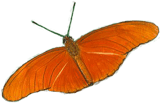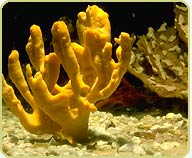 Invertebrates
are the most abundant creatures on earth, crawling,
flying, floating, or swimming in virtually all of
Earth's habitats, from townhouses to tropical rainforests.
Yet most of us rarely notice them unless they're in
our gardens or on our dinner plates.
Invertebrates
are the most abundant creatures on earth, crawling,
flying, floating, or swimming in virtually all of
Earth's habitats, from townhouses to tropical rainforests.
Yet most of us rarely notice them unless they're in
our gardens or on our dinner plates.
Invertebrates—creatures without backbones—are
nature's unsung heroes, quietly playing vital roles
in earth's ecosystems. About 99 percent
of all known living species are invertebrates. Vertebrates—fish,
amphibians, reptiles, birds, and mammals—make
up a tiny fraction of life on earth. ![]() more about the silent majority
more about the silent majority
It is nearly impossible to go a day without encountering one of the million species of arthropods. Most of them are insects, and many others are spiders.
Cuttlefish Hatch by the Hundreds
 Hundreds of common cuttlefish have hatched at the Zoo's Invertebrate Exhibit. These jet-propelled animals can change their color to match their surroundings. This is the first time in the Zoo's history that adult cuttlefish have mated and laid eggs, and babies have hatched and developed. Many are on exhibit in the tank with the chambered nautiluses.
Hundreds of common cuttlefish have hatched at the Zoo's Invertebrate Exhibit. These jet-propelled animals can change their color to match their surroundings. This is the first time in the Zoo's history that adult cuttlefish have mated and laid eggs, and babies have hatched and developed. Many are on exhibit in the tank with the chambered nautiluses. ![]() Find out more.
Find out more.
Caring for Coral
Zoo scientsts rally to collect, breed, and protect threatened coral. ![]() Read all about their efforts in Smithsonian Zoogoer.
Read all about their efforts in Smithsonian Zoogoer.
At the Zoo
 The Zoo's Invertebrate Exhibit is home to dozens of invertebrate species, from sea stars to spiny lobsters to giant African millipedes to tarantulas to a giant Pacific octopus, which can be seen on our
The Zoo's Invertebrate Exhibit is home to dozens of invertebrate species, from sea stars to spiny lobsters to giant African millipedes to tarantulas to a giant Pacific octopus, which can be seen on our ![]() web cam below.
web cam below.
Visitors can also see beautiful zebra longwing, orange julia, and erato butterflies in our Pollinarium. ![]() more
more
![]() Invertebrate Photo Gallery |
Invertebrate Photo Gallery |
![]() Help with cam
Help with cam
Can’t see any animals?
The animal in this exhibit may have moved out of view. FONZ volunteers operate some cams, but most of our cams show a fixed view.
The giant Pacific octopus
is the world's largest octopus—large males may have an arm span up to 25 feet and weigh more than 100 pounds. Octopuses are mollusks, and are related to squid, cuttlefish, and nautiluses.
![]() Octopus facts |
Octopus facts | ![]() Ocean Living photo gallery
Ocean Living photo gallery
Microtheater
At the Invertebrate Exhibit
 What looks like a walnut, refracts light, and swims? An animal that can be seen at the Invertebrate Exhibit: the sea walnut, a kind of ctenophore (pronounced TEN-uh-fore) or comb jelly. Shown at left, the sea walnuts eat zooplankton and usually drift with the water current. They display rainbow colors when light hits their rows of moving cilia (short hair-like structures), which are used for locomotion. There are dozens of ctenophore species. You can see Mnemiopsis leidyi in a small tank near the giant Pacific octopus.
What looks like a walnut, refracts light, and swims? An animal that can be seen at the Invertebrate Exhibit: the sea walnut, a kind of ctenophore (pronounced TEN-uh-fore) or comb jelly. Shown at left, the sea walnuts eat zooplankton and usually drift with the water current. They display rainbow colors when light hits their rows of moving cilia (short hair-like structures), which are used for locomotion. There are dozens of ctenophore species. You can see Mnemiopsis leidyi in a small tank near the giant Pacific octopus.
Several common cuttlefish (Sepia officinalis) can also be seen at the Invertebrate Exhibit. These cephalopods are fed three times a day and delight visitors with dramatic color and pattern changes.
Chesapeake Bay Crab Exhibit
 The Blue Crab and the Bay exhibit, located at the Invertebrate Exhibit, highlights the biology of the blue crab, Callinectes sapidus, focusing on its lifecycle and its environment in the Chesapeake Bay.
The Blue Crab and the Bay exhibit, located at the Invertebrate Exhibit, highlights the biology of the blue crab, Callinectes sapidus, focusing on its lifecycle and its environment in the Chesapeake Bay. ![]() Find out more.
Find out more.
Every day staff and volunteers welcome visitors into the world of invertebrates through conversation, demonstrations,
and science-based discussions.
Special demonstrations
and activities occur throughout the day. The animals
are housed in aquariums and terrestrial exhibits. ![]() exhibit
details
exhibit
details
For a journey into the realm of the fascinating, odd, graceful, and the ecologically complex, visit the Invertebrate Exhibit.




